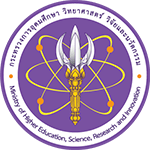3-GeV Synchrotron Facility
Synchrotron Light Research Institute (SLRI) has started a project on a new 3.0 GeV synchrotron light source to be located in the Eastern Economic Corridor of Innovation (EECi), aiming to make it a leading synchrotron facility in the Asia-Pacific region for researches in medical science, agriculture, industry, etc.
A synchrotron light source is a crucial scientific infrastructure and has been recognized by developed countries as a powerful tool for advanced technologies and innovation. It has tremendous benefits for researches in medicine, agriculture, industry and other areas to support country development in various aspects such as economy, society, human capital, etc. The new synchrotron light source has electron beam energy at 3 GeV and circumference of 321.3 meters with cutting-edge technology called double triple bend achromat (DTBA) which will result in bright synchrotron light approximately 1 million times of the existing one produced from the current 1.2 GeV synchrotron light source. The new light source can accommodate up to 22 beam lines which can be applied for a variety of research applications. The location of new light source is agreed to be in the area of the Eastern Economic Corridor of Innovation (EECi), Rayong Province, Thailand, due to several factors: (1) geological stability; (2) transportation accessibility; (3) industrial estate locating nearby; (4) neighboring scientific research institutes and universities in Eastern Economic Corridor (EEC) area; and (5) cooperation and joint venture with private sectors in response to government’s Eastern Economic Corridor (EEC) development plan. This project will promote the large investment for economic growth and firmly and sustainably elevates country development due to the “Thailand 4.0” model.

The SLRI Siam Photon Source-II (SPS-II) project is set up to build the 3 GeV synchrotron light source, the large research infrastructure of Thailand. It will advantage to the country by creating jobs, careers, and developing skilled laborers in construction, machines, designing, manufacturing parts, and project operations. Once the construction has been completed, the light source can also serve private sectors and raise the economic value to at least 6,000 million baths a year. The new 3.0 GeV synchrotron light source can support varieties of research such as:
- Medical science: to study structure of proteins, viruses and enzymes to find the mechanism of infection leading to development of new medicines, enhancing medical and pharmaceutical capabilities
- Food and agriculture: to increase value product management, agricultural engineering process, food processing, quality improvement, safety of food through packaging in accordance with government plans for food and agricultural industry development
- Advanced materials industry: to help analyzing the changes of material sample properties under different environments, to support research and development of construction material application such as new concrete formulas, metals andnew composite materials
- Environment: to help in contamination analysis in a more precise environment, to find the link between plant diseases and molecules that the plant can absorb leading to finding ways to prevent disease in plants and reduce economic losses.
- Archeology: forensic archeology studies which will be a structural analysis at the atomic level in depth, both finding the source as well as the simulation of 3D structures using synchrotron-based techniques in order to solve the missing ancient information and the production of new products for restorations

In addition, the new 3 GeV synchrotron light source to be constructed at EECi, has a comprehensive safety management in all aspects, especially preventing radiation hazards from synchrotron production. There are also strict safety, health and environmental management systems complying with laws and international standards. Radiation safety for the operation of the new 3 GeV synchrotron light source has begun with radiation evaluation from sources to properly design the shielding wall for particle accelerators tunnels, electron storage ring, beam line and end station. The computational simulation can determine specifications of shielding walls and evaluate their effectiveness prior to an actual construction. The radiation must be routinely measured during operation to certify safety validation. The amount of radiation must be controlled at minimal for radiation workers and related personnel in accordance to safety regulation of Thai laws and international standards of IAEA under strict control by the Office of Atoms for Peace.



